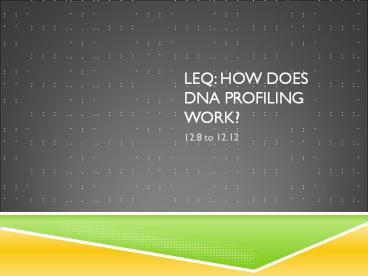LEQ: How Does DNA profiling work? - PowerPoint PPT Presentation
1 / 8
Title:
LEQ: How Does DNA profiling work?
Description:
LEQ: HOW DOES DNA PROFILING WORK? 12.8 to 12.12 NUCLEIC ACID PROBES Short single strands of DNA w/ specific nucleotide sequences are created using radioactive isotope ... – PowerPoint PPT presentation
Number of Views:123
Avg rating:3.0/5.0
Title: LEQ: How Does DNA profiling work?
1
LEQ How Does DNA profiling work?
- 12.8 to 12.12
2
Nucleic Acid Probes
- Short single strands of DNA w/ specific
nucleotide sequences are created using
radioactive isotope or dye - These probes are used to find a specific gene or
nucleotide sequence the probe hydrogen bonds to
gene of interest
3
DNA Microarray
4
DNA Microarray test for gene activity
- mRNA that produces protein of interest is
isolated, reverse transcriptase fluorescent
nucleotides are added - cDNA is made from RNA
- cDNA is applied to well that contain DNA from a
cell cDNA will bind to DNA that is complementary
in the wells - Rinse unbound cDNA fluorescent spots show DNA
that is being expressed by the cell no glow
unexpressed DNA - Enables a researcher to determine what genes are
turned on or off in a cell
5
Gel Electrophoresis
- Negatively charged DNA is placed into the wells
at the negative end of the gel apply current
negative DNA is pulled to the positive end
smaller pieces travel farther faster DNA
fragments are separated based on the size of the
fragment ( of base pairs).
6
Restriction Fragment Length Polymorphisms (rflps)
- (rif'-lips) The differences in homologous DNA
sequences that are reflected in different lengths
of restriction fragments produced when the DNA is
cut up with restriction enzymes - Here you are looking at homologous chromosome
segments one from a crime scene and the other
from the suspect when you cut both with the same
restriction enzyme, they produce different
banding patterns This tells you the crime scene
DNA did not come from the suspect
7
RFLIPs used to ID Harmful alleles
- Compare individual that has a disease/harmful
allele to others. Digest DNA from all
individuals using same restriction enzyme. Run
gel electrophoresis. Blot DNA (pick up DNA using
special filter paper). Apply radioactive probe
designed to detect (bind to) harmful allele /
gene of interest. Unattached probes are rinsed
off. Photographic film used to form a image that
compares individuals. In this picture I had
the harmful allele. If any individual matches
the banding pattern of I, then they also have the
harmful allele. Individual II has the harmful
allele but III doesnt.
8
DNA Fingerprinting
- A procedure that analyzes an individuals unique
collection of DNA restriction fragments, detected
by electrophoresis and nucleic acid probes. DNA
fingerprinting can be used to determine whether
two samples of genetic material are from the same
individual. - Used to convict criminals, determine paternity,
exonerate innocent individuals, etc































